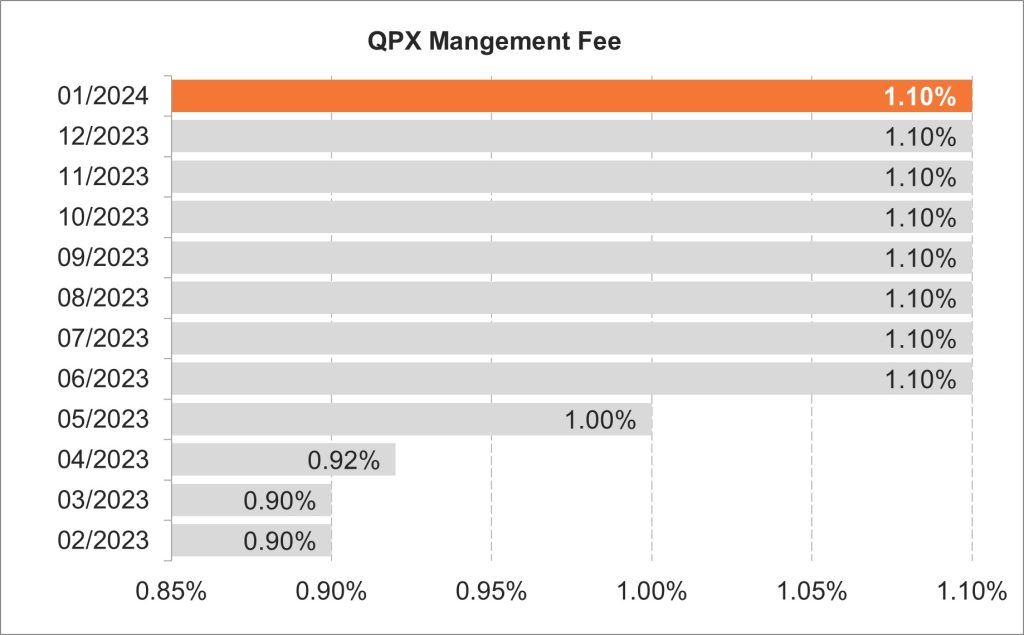QPX: 4th Quarter 2023 Portfolio Review
Portfolio Strategy
The AdvisorShares Q Dynamic Growth ETF (QPX) seeks to target equity market upside while tactically managing downside risk during abnormal market volatility. Using ETFs, QPX may invest in a broad variety of equities across market cap, style or sectors and will use various fixed income categories and commodities to manage risk. Normally, QPX seeks to provide broad-market equity-like returns. However, during periods of high market volatility, QPX can allocate to a more defensive portfolio and seek short-term fixed income returns.
QPX’s market volatility indicator, the proprietary Q Implied Volatility Index™ (QIX), is reviewed daily and will determine certain allocation changes. When the QIX indicates normal volatility, QPX will have long equity exposure; when the QIX is higher but at intermediary levels, QPX moves to a balanced equity / fixed income portfolio, finally when QIX is at its highest levels, QPX moves to a defensive allocation.
Portfolio Review
For the fourth quarter of 2023, QPX finished ahead of its benchmark, the S&P 500 Index.
QPX was mainly invested in the technology, healthcare, and consumer staples, as this exposure has a much higher risk/reward characteristics than other segments of the market per the portfolio manager’s models. It also divested from QQQ, in order to provide a cleaner interpretation/communication of the sector exposure.
During the fourth quarter, the QIX stayed below the volatility trigger. Therefore, there were no risk-off rebalancing allocation changes made in QPX during the period.
Top Holdings
| Ticker | Security Description | Portfolio Weight % |
| XLK | TECHNOLOGY SELECT SECT SPDR | 23.27% |
| QQQ | INVESCO QQQ TRUST SERIES 1 | 20.43% |
| XLY | CONSUMER DISCRETIONARY SELT | 17.39% |
| IYW | iShares USTechnology ETF | 14.83% |
| XLC | COMM SERV SELECT SECTOR SPDR | 6.21% |
| GLD | SPDR GOLD SHARES | 6.18% |
| IAUF | ISHARES GOLD STRATEGY ETF | 5.45% |
| BLV | VANGUARD LONG-TERM BOND ETF | 3.59% |
As of 12.31.2023. Cash not included. Subject to change.
 Respectfully,
Respectfully,
Ron Piccinini
ThinkBetter, LLC
AdvisorShares Q Dynamic Growth ETF (QPX) Portfolio Strategist
Management Fee
 The portfolio strategist of QPX has “skin in the game.” The strategist’s compensation is directly tied to the portfolio’s performance. Using the trailing 12-month returns of QPX vs. its S&P 500 Index benchmark, stronger outperformance is rewarded with a larger management fee while weaker underperformance is penalized with a smaller management fee. The QPX fulcrum fee was 1.10% during October, November, and December 2023. After the Fund’s December performance, the QPX fulcrum fee will remain at 1.10% in January 2024.
The portfolio strategist of QPX has “skin in the game.” The strategist’s compensation is directly tied to the portfolio’s performance. Using the trailing 12-month returns of QPX vs. its S&P 500 Index benchmark, stronger outperformance is rewarded with a larger management fee while weaker underperformance is penalized with a smaller management fee. The QPX fulcrum fee was 1.10% during October, November, and December 2023. After the Fund’s December performance, the QPX fulcrum fee will remain at 1.10% in January 2024.
Past Commentary
Definitions:
The S&P 500 Index is a broad-based, unmanaged measurement of changes in stock market conditions based on the average of 500 widely held common stocks. One cannot invest directly in an index.
Before investing you should carefully consider the Fund’s investment objectives, risks, charges and expenses. This and other information is in the prospectus, a copy of which may be obtained by visiting www.advisorshares.com. Please read the prospectus carefully before you invest. Foreside Fund Services, LLC, distributor.
Investing involves risk Including possible loss of principal.
There is no guarantee the Advisors investment strategy will be successful. When models and data prove to be incorrect or incomplete, any decisions made in reliance thereon expose the Fund to potential risks. In addition, the use of predictive models has inherent risk. Because predictive models are usually constructed based on historical data supplied by third parties, the success of relying on such models may depend heavily on the accuracy and reliability of the supplied historical data. The Fund’s particular allocations may have a significant effect on the Fund’s performance. Allocation risk is the risk that the selection of ETFs and the allocation of assets among such ETFs will cause the Fund to underperform other funds with a similar investment objective that do not allocate their assets in the same manner or the market as a whole. For a list of the asset class specific risks please see the prospectus.
